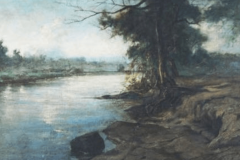Buying Fabian De La Rosa paintings – Highest Prices Paid: Artist Bio & images follow:
FABIAN CUETO DE LA ROSA
Artist Fabian Cueto De La Rosa was born in Manila on the 5th of May, 1869. He was the second child of Marcos de la Rosa and Gregoria Cueto. Among his relatives were Simon Flores y De La Rosa ( an uncle) and his nephews later included Fernando and Pablo Amorsolo. De La Rosa later served as a mentor to Fernando Amorsolor, encouraging him to pursue painting.
He received his first art lessons were given by an aunt, Mariana De La Rosa, at the age of 10. He later enrolled at the Escuela de Bellas Artes y Dibujo under Agustin Saez, but dropped out after three years. In 1893 he enrolled in the Escuela Superior de Pintura, directed by Don Lorenzo Rocha. Later, he also took painting lessons from Lorenzo Guerrero and Miguel Zaragoza.
He was married, on January 13th 1900, to Gorgonia Tolentino. The couple never bore children, but their orphaned nephews Pablo and Amorsolo were very close to them, and stayed with them in 1903.
In 1908 the Germinal Cigar Factory sent him to Europe as a scholar. The schools he attended included the Academie Julien in Paris. Upon his return to Manila, along with other artists who had studied with him in Europe, he became one of the first faculty members of the University of the Philippines (UP) School of Fine Arts. He introduced and taught decorative painting at the University. He also painted portraits to support himself.
During the period of 1927 through 1937, he served as the school’s director. In 1928, taking leave from his directorship, he sailed to Europe for the second time accompanied by his wife. He painted in Paris for four months and then traveled to Munich, Geneva, Rome, and Madrid. In 1928 he presented a much acclaimed exhibition of his paintings at the Ateneo de Madrid.
Fabian De La Rosa is reputed to have produced about 1,000 works in his lifetime. Aurelio S. Alvero divides his works into three periods. In the first period, De la Rosa’s emphasis is academic, detailing figures while paying little attention to atmosphere. Notable works from this period include “Transplanting Rice,” which won De La Rosa the gold medal at the International Exposition held in St. Louis, Missouri in 1904, and also “The Death of General Lawton,” which won a bronze medal in the same exposition.
The second period, which includes works De La Rosa executed in Europe, shows a transition from academic figures to atmospheric effects. Examples from this period include “El Kindiman,” 1930, and “Markina Road,” circa 1939.
In his third period, De la Rosa emphasizes the play of colors in favor over mass and space. Typical of this period is the painting “Fishermen’s Huts on Balut Island,” Tondo, considered by Aurelio Alvero to be De La Rosa’s finest landscape painting.
Other notable paintings by De la Rosa include “Landscape with Dark Trees, 1927,” “La pintura,” 1926, “La Bordadora,”
(The Embroiderer) circa 1926. He also executed a “View of Santa Ana” dated December, 1937. His wife Gorgonio died of cancer in 1937, and the artist was left living alone, suffering from kidney disease. He died on December 15, 1938 at the Kraut Apartments in Quiapo, Manila.
De la Rosa received posthumously the Patnubay ng Sining at Kalinagan award from the City of Manila in 1968.
Do you have artwork by this artist that you are interested in evaluating or selling?
INQUIRE ABOUT YOUR ARTWORK






